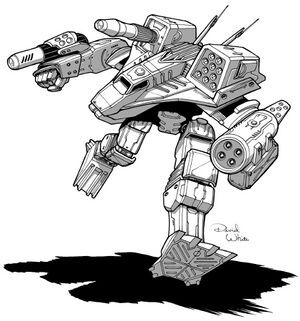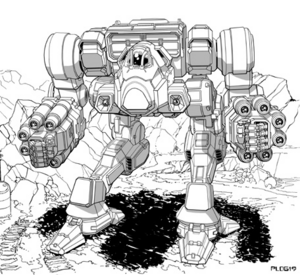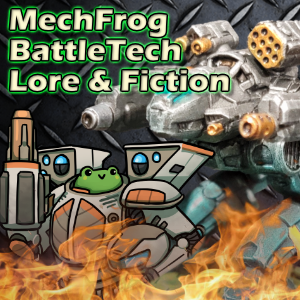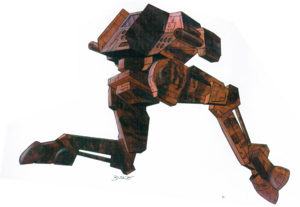OmniMech
Sarna News

- HEXTECH Review - Wave 3 Brings More Urban Options To Your Battlefield
- Your BattleTech News Round-Up For March, 2024
- Crashing 'Mechs With Jennifer Brozek, Author Of The Rogue Academy Trilogy
- Getting The Word Out With Rem Alternis, Catalyst Community & Marketing Director
- Bad 'Mechs - Yeoman
- Read more →
An OmniMech is a highly configurable type of BattleMech developed by Clan Coyote during the Golden Century. OmniMechs mount some (or all) of their loadout in modular OmniMech-compatible OmniPods. This gives Omnis the ability to replace damaged components and change battlefield role to fulfill changing mission requirements. OmniPods can contain a wide range of weapon systems and a limited selection of structural components and equipment. An OmniMech's tactical capabilities are mostly limited by durability, movement profile, and the amount of Pod Space the OmniMech has (both in mass and bulk), though OmniMech logistics, like available Pod-mounted components, facilities, and even short reconfiguration times, can also affect performance strategically.
Contents
History[edit]
Development[edit]

Based on the modular replacement system of the Mercury BattleMech, OmniMech technology was developed by a team of Clan Coyote scientists led by Scientist Richard (Remer) with the assistance of Clan Sea Fox. In 2854, their collaboration resulted in Clan Coyote's Coyotl, the first true OmniMech. The Coyotl's OmniMech technology provided far more flexibility than the Mercury's semi-modular Hessen IX Small Lasers.[1] Clans Coyote and Sea Fox had evolved the technology to allow complete quick reconfiguration of the weapon systems and certain structural components. OmniMech customization and repair required as little as 30 minutes for all of the Pod-mounted components in an entire location, a very small fraction of the time required for an equivalent modification or repair for conventional BattleMechs.[2][3][4][5][6]
Prototype OmniMech design was hampered by several major problems in stability, targeting, logistics, and construction. The OmniMech gyro had to adapt to large changes in the center of mass of the 'Mech. Without specialized software and extreme increases in the gyro's physical tolerance, the OmniMech would not be as stable as a conventional BattleMech. Changing loadouts quickly also required the OmniMech battle computer to accept "snap and go" software for its targeting and tracking system. Combat effectiveness was still paramount, so the frame of the OmniMech could not waste space and mass for the physical interfaces of interchangeable equipment. Only standardized, specially constructed OmniMech components could be utilized on the OmniMech's frame. Richard (Remer) and his team worked for six full years to solve most of these complications before prototype OmniMechs began combat trials, and another eighteen months before the Coyotl entered full service.[3][7][5] Even with deployment of the Coyotl, modular OmniTechnology required years of additional refinement to ease compatibility between XL fusion engines and Endo-steel internal structure on an OmniMech chassis, and researchers never improved (or never attempted to improve) arm OmniPod attachment points to allow large-bore weapon systems to be mounted in an arm with lower arm and hand actuators.[2][8]
Proliferation[edit]
The OmniMech's adaptability resulted in revolutionary changes on the battlefield. An OmniMech was more tactically and strategically flexible than any BattleMech before, allowing Clan Coyote (and to a lesser extent, the demurring Sea Foxes) to choose the capabilities of a machine depending upon the requirements of a particular mission. The major limitation to this flexibility was the mass the chassis could support. Size constrained the speed, armor and Pod Space of the Coyotl. This was quickly addressed with the introduction of at least three more first-generation OmniMechs, each a different drop weight.[2][3][4][5]
The first-generation OmniMechs were overlooked for only a few years. Clan Coyote's OmniMechs soon became dominant on the Clan battlefield, and Clan Coyote began to expand within the Kerensky Cluster. By 2858, Coyote successes on the battlefield prompted Clan Jade Falcon and three of its allies to approach the Clan Council and demand OmniMech technology be shared. Their demands were met with hostility from Clan Coyote and its allies, most notably Clan Wolf. The Clan Council negotiated for a full week, and compromised between the two camps. Every Clan was allowed a single, yearly opportunity to acquire OmniMech technology honorably through martial prowess. Feigning neutrality during the discussions,[9] Clan Burrock Khan Zenos Danforth was elected ilKhan and tasked with adjudicating the results of the Trials for OmniMech Technology.[10][4] Just a year later, Clan Coyote equipped nearly all of its Alpha Galaxy with OmniMechs, and accelerated its expansion despite the Trials. By the time Clan Jade Falcon won the prized technology in 2863, Clan Coyote's OmniMechs had been nearly unstoppable on the battlefields of the Clan Homeworlds for almost a decade.[2][4][5]
Once Clan Jade Falcon won OmniMech technology from Clan Coyote, its spread throughout the Kerensky Cluster was inexorable. This was in part because each Clan with OmniMech technology could be challenged to a Trial of Possession. By the end of the next calendar year, six more Clans had won Trials of Possession for the technology.[4] The final Clan to acquire OmniMech technology was Clan Ghost Bear, who took it from Clan Hell's Horses in 2873.[11] Despite Omni technology's spread throughout the Clans, most Clans still required years to incorporate the technology, gain expertise, introduce their own novel OmniMechs, and build their infrastructure and production. Committed to maintaining their edge, Clan Coyote began to aid their allies, including Clan Wolf, in designing their own OmniMechs. In addition, Clan Coyote expanded its touman's access to OmniMechs, especially outside Alpha Galaxy, through the "Pueblo Initiative", a feverish effort to reduce OmniMech development time and expand production by modifying the construction of existing of Star League BattleMechs into new, Clan OmniMechs. In 2865 Clan Coyote began widespread production of the first Pueblo Initiative OmniMech, the Night Chanter, an OmniMech based on the ubiquitous Crab. Though moderately successful, the Pueblo Initiative's increase in production and use of established Star League designs may have accelerated the spread of OmniMechs, allowing adversaries with limited resources and expertise, for instance Kindraa Smythe-Jewel, to become acclimated to the technology faster and begin manufacturing OmniMechs. Despite their missteps, widespread production, years more experience, and a greater variety of OmniMechs available allowed Clan Coyote and their allies sustained superiority in OmniMech technology for many years.[4][12][13]
Mechanized Infantry[edit]

An unexpected advantage of their advanced gyros, OmniMechs could also be used extensively as infantry transports. In 2867, Clan Wolf began development of battle armored infantry, based on underwater environmental suits used by Clan Goliath Scorpion in the seas of Dagda and Star League Power Armor (Light). The classic Elemental battle armor, a blend of speed, anti-'Mech capability, protection, and firepower, prevailed. The Elemental debuted in 2868 in combat against Clan Nova Cat, and soundly won. Clan Wolf's battle armor concept revolutionized offensive ground infantry combat in twenty-ninth-century Clan warfare, and accelerated the propagation of the new "Elemental" warrior phenotype developed by Clan Hell's Horses.[2][14][15][16][17][18] However, Elementals have limited mobility; they are only capable of a single 90-meter leap every 10 seconds and are nearly one ton in mass.[17] Without Combat Vehicles dedicated to moving soldiers or longer-ranged battle armor weaponry, Elementals could only be used effectively on land as fixed defenders against experienced adversaries. Rather than rely entirely on combat vehicles to transport infantry, Clan Hell's Horses OmniMech designers realized the specialized gyros of OmniMechs could allow the mass of a point of Elementals to mount and dismount under fire. In 2870 they debuted their first OmniMech, the Nova, which mounted handholds, power outlets, and communication ports for battle armor. The Nova's mechanized infantry modifications were very successful and universally copied.[19][20][21] Existing OmniMechs could have been refitted and retrofitted, but this has not been explicitly stated.[22][23][24] Within six years of the initial Wolf-Nova Cat Trial and just four years after the debut of the Nova, the concept of OmniMechs as infantry transports was taken to its logical conclusion, when Clan Ghost Bear began production of the Cloud Cobra-prototype Fire Moth infantry support OmniMech.[25][26]
Inner Sphere Development[edit]
The OmniMech's ease of repair, rearmament, and weapons loadout modification allowed Clan MechWarriors to quickly return to the battlefield, and kept the Clans moving at an amazing pace during the Clans' invasion of the Inner Sphere.[27] But the Clans' obvious technological advantage resulted in a rapid response from Inner Sphere weapons manufacturers. While not able to replicate the advanced construction materials of the invaders, the Inner Sphere was able to reverse engineer OmniMech technology from captured or crippled machines. Thanks to the pristine examples gained from the Battle of Wolcott and several Galaxies' worth of salvage in the aftermath of the Operation DRAGONSLAYER, the Draconis Combine led Inner Sphere OmniMech development. Just five months after DRAGONSLAYER, as the Com Guards fought the Clans on Tukayyid, the Draconis Combine introduced the first Inner Sphere OmniMech, the Raptor, in May 3052.[28] By 3058 the Combine had eight separate OmniMechs in production with licensed versions being built in the Lyran Alliance, St. Ives Compact, Capellan Confederation, Free Worlds League, and Federated Commonwealth. By 3067 every Successor State had designed and begun production of its own, novel OmniMech(s).[29][30]
Advantages[edit]
The OmniMech's flexibility has many advantages. The modular construction allows MechWarriors to customize their machine's weapon loadout to suit their own skills and preference, and to suit specific tactical or environmental needs as required. Where a BattleMech of comparable weight is often designed and built for a specific role, an OmniMech can serve many roles based upon its configuration, for instance as a direct-fire combatant one day and a missile boat the next.[27] A single 'Mech capable of performing multiple roles frees up significant logistical space and mass during a campaign, assuming the OmniMech is repairable after each mission.[30]
Though not solely created for modular weapon loadouts, the OmniMech design greatly aids repair and construction. If a weapon Pod is damaged, it can be quickly detached and replaced with another while the original is repaired. If certain weapons or ammunition are unavailable, alternates can be easily substituted. Once their modular weaponry and equipment is removed, the empty bays provide better access to repair the chassis. Damaged components such as arms and legs can be easily repaired in half the time it takes for common BattleMechs, and often with less experienced technicians able perform such tasks.[27] OmniMech technology also greatly aids salvage. Even if an enemy OmniMech is virtually destroyed, an intact OmniPod can be detached and mounted on a functional Omni just as quickly and easily as if it was factory fresh, satisfying the Clans' overriding desire to avoid waste.
OmniTechnology has also been used to bridge the technological gap between the Clans and the Inner Sphere. While Inner Sphere and Clan components are generally mutually incompatible, the Inner Sphere reverse-engineered their OmniMech technology from Clan salvage after the successful operations against the Clans, including the Battle of Luthien, the Battle of Wolcott, and the Battle of Tukayyid[31]. The resulting systems use a similar OmniPod interface. With rare exceptions (for instance, early production runs of the Firestarter OmniMech), Inner Sphere and Clan Omnis can mount either Inner Sphere or Clan OmniPods interchangeably.[32]
The OmniMech's ability to provide transport for mechanized battle armor is another distinct advantage. Clan OmniMechs are capable of deploying and redeploying PA(L)-, light-, medium-, and heavy-classes of battle armor[33] much more expeditiously than allowing the infantry to deploy on their own. Additionally, while battle armor is mounted on the OmniMech, the battle armor provides a modicum of additional protection to their transport.[20][23] Quad and assault-class battle armor are incapable of mechanization.[33] Initially Inner Sphere battle armor were also incapable of mounting Clan OmniMechs[20], though with decades of experience Inner Sphere battle armor has reached greater parity with their Clan counterparts[23]. Newer battle armor, equipped with magnetic clamps, may also mount standard BattleMechs, but BattleMechs do not have specialized OmniMech gyros and suffer reduced mobility compared with their OmniMech counterparts.[23]
Disadvantages[edit]
Despite their benefits in flexibility and maintenance, OmniMechs have distinct limitations in regard to capabilities, cost, and logistics.
OmniMechs constructed from standard materials are more expensive than comparable BattleMechs of similar weight. While the initial invasion gave the impression that Clan toumans consisted solely of OmniMechs, even the wealthiest or most powerful Clans can only afford to outfit their front-line formations with OmniMechs. Second-line forces in most Clans generally utilize more cost-effective standard, Clan-tech BattleMechs, or old Star League designs.[34]
OmniMech Pod-mounted weaponry and equipment is incompatible with standard BattleMechs. Even for identical classes and brands of equipment, only ammunition can be installed interchangeably. Adding or removing the OmniPod connections to weapons and equipment is possible, albeit time consuming, and adds additional time to repairs. For mixed formations of BattleMechs and OmniMechs this adds an artificial separation for spare parts, and requires duplication in supply chains and logistics.[32]
OmniMechs are not fully modular. An OmniMech's structural components (its engine, internal structure, armor, and any equipment installed on the base chassis) are hardwired.[35] Redesign, though not impossible, is significantly more complicated than reconfiguration to the point of "reek[ing] of desperation"[36]. Weapons and equipment not mounted in OmniPods can still be installed as fixed equipment in an OmniMech, effectively partially transforming the OmniMech into a standard BattleMech. Unfortunately, customizing an OmniMech is as difficult as customizing a standard BattleMech, and takes longer than simple reconfiguration using OmniPods.[37]
While actuators are a type of structural component, the lower-arm and hand actuators are themselves OmniPod-mounted. Arm actuators can be easily removed to provide additional Pod Space in the arms. However, hand and lower-arm actuators use the same mounting points as larger-bore ballistic and energy weapons, including Gauss rifles, Autocannons, and PPCs. OmniMech configurations mounting these types of weapons in the arms are only able to mount upper-arm actuators, impairing their ability to perform certain physical attacks.[8]
See Also[edit]
References[edit]
- ↑ Technical Readout: 2750", p. 16
- ↑ 2.0 2.1 2.2 2.3 2.4 Era Digest: Golden Century, p. 6
- ↑ 3.0 3.1 3.2 Era Digest: Golden Century, p. 22
- ↑ 4.0 4.1 4.2 4.3 4.4 4.5 Field Manual: Warden Clans, p. 41
- ↑ 5.0 5.1 5.2 5.3 Field Manual: Warden Clans, p. 59
- ↑ Strategic Operations, pp. 183–185: "Master Repair Table"
- ↑ Field Manual: Warden Clans, pp. 40–42: "Birth of the Titans" & "Crusade of the Valiant"
- ↑ 8.0 8.1 TechManual, p. 57: "BattleMech Construction - Step 5: Add Weapons, Ammunition and Other Equipment"
- ↑ Shrapnel, Issue #8, p. 45: "Executioner-B"
- ↑ Era Digest: Golden Century, p. 10
- ↑ Field Manual: Warden Clans, p. 79
- ↑ Era Digest: Golden Century, p. 25
- ↑ Turning Points: Foster, p. 19: "Night Chanter" and "Spirit Walker"
- ↑ Field Manual: Crusader Clans, p. 135
- ↑ Field Manual: Crusader Clans, p. 54
- ↑ Technical Readout: 3058 Upgrade, p. 40
- ↑ 17.0 17.1 Technical Readout: 3058 Upgrade, p. 44
- ↑ Technical Readout: 3050 Upgrade, p. 112
- ↑ Technical Readout: 3050 Upgrade, p. 126
- ↑ 20.0 20.1 20.2 Technical Readout: 3050, p. 225
- ↑ Technical Readout: 3050 Upgrade, p. 112
- ↑ Mechanized Battle Armor with Early OmniMechs forum topic
- ↑ 23.0 23.1 23.2 23.3 Total Warfare, pp. 226-227: "Mechanized Battle Armor"
- ↑ TechManual, p. 157
- ↑ Era Digest: Golden Century, p. 21
- ↑ Technical Readout: 3050 Upgrade, p. 114
- ↑ 27.0 27.1 27.2 Technical Readout: 3050, p. 7
- ↑ Technical Readout: 3058 Upgrade, p. 120: "RTX1-O Raptor"
- ↑ Technical Readout: 3058, pp. 78–95
- ↑ 30.0 30.1 Era Report: 3062, p. 105: "Museum Technica - Production Directed - OmniMechs"
- ↑ Shrapnel, Issue #11, pp. 38-40: BTL-C-2O Battle Cobra
- ↑ 32.0 32.1 Campaign Operations, p. 208: "Clan/Inner Sphere Incompatibility"
- ↑ 33.0 33.1 TechManual, p. 167, "Battle Armor Capabilities Table"
- ↑ Technical Readout: 3055, p. 92
- ↑ TechManual, p. 53: "BattleMech Construction - Step 2: Install Engines and Control Systems"
- ↑ Recognition Guide: ilClan, vol. 26, p. 10
- ↑ Strategic Operations, p. 189, "Customizing"
Bibliography[edit]
- Campaign Operations
- Era Digest: Golden Century
- Era Report: 3062
- Field Manual: Crusader Clans
- Field Manual: Warden Clans
- Recognition Guide: ilClan, vol. 26
- Shrapnel, Issue #8
- Shrapnel, Issue #11
- Strategic Operations
- TechManual
- Technical Readout: 2750
- Technical Readout: 3050
- Technical Readout: 3050 Upgrade
- Technical Readout: 3055
- Technical Readout: 3058
- Technical Readout: 3058 Upgrade
- Turning Points: Foster


